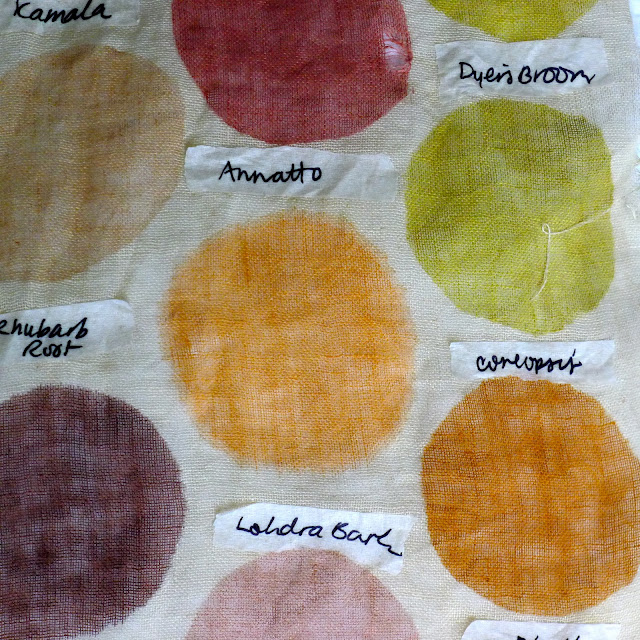
In October, I temporarily left the hive to move to London, England, while I study for my master's degree in textiles at Chelsea College of Art & Design. I chose Chelsea because its Textile program has a focus on sustainability, which is becoming an increasingly important aspect of my work, and outlook on life. Chelsea has an unique research centre, TED (Textiles Environment Design) which is part of a larger partnership with Central Saint Martin's called the Textile Futures Research Centre. For anyone interested in textiles in general and sustainability specifically, explore both their websites for volumes of fascinating research and inspiring projects.

My MA project focuses on natural dye printing, something with which I've long wanted to experiment. So much of my own work and teaching involves screenprinting, and as much as I love the beautiful effect of printing with conventional fibre-reactive or acid dyes, I worry about the long term health and environmental effects of all the chemicals involved in the process. I've had a lot of experience using natural dyes for immersion dyeing, some of which we've shared with you here on the Beehive, but little experience with using natural dyes for printing. I had a sense of how they might work for printing, but I'd never really tried to use them.
I thought the perfect way to begin would be to take a workshop at the Maiwa Symposium in Vancouver, which is also something I've always longed to do but could never fit in, as the symposium falls during the fall school term. The workshop at Maiwa gave me the confidence to get going!


Since arriving in London and settling into the studio at Chelsea, I've been experimenting with the colours I can produce using the various natural dye extracts available from different sources. Maiwa, Couleurs des Plantes, Couleur Garance, Earthues and Pure Tinctoria all sell a variety of ready-to-use natural dye extracts from ethical and sustainable sources. The extracts are relatively easy to use as they dissolve in water, but you can also make your own extracts from dried or fresh dyestuffs.
I thicken the extracts with a gum to produce a paste appropriate for screen printing. So far, as I'm only in the early stages of testing, I'm stencilling the print pastes onto mordanted cloth rather than screen printing, which will come later. The colour testing will also involve pushing the range of hues by shifting colours by adding acid, alkaline or other mordants to the colour after it has been applied. What you see here are some of my early samples in progress, which give you an idea of the range of colour you can achieve using all natural colourants, all derived from plant and a few insect sources.


A large part of my investigation is researching the plants that produce dyes, and their chemical, cultural and economic histories. I've been making ink and crayon drawings of these plants from historical herbaria (scrapbooks of preserved dried plant specimens) to develop imagery which I will later use in screen printed patterns.
When I return home, I hope to share my newly gained knowledge with anyone wanting to learn more about these precious and wonderful sources of colour. Read more about my project over the next 6 months as it progresses on my blog, now up and running again after months and months of neglect!

This is really awesome! Thank you for sharing
ReplyDeleteWhat an amazing Masters Thesis and thank you for sharing!
ReplyDeleteInteresting idea to natural dyes for screenprinting. i am curious how you'll fix your inks/dyes? one of the reasons I have not engaged more in natural dyeing in my fibers is because you have to use a harsh chemical mordant to make them permanent. I thought this kind of cancelled out the benefit of using natural dyes.
ReplyDeleteHi Ashley,
ReplyDeleteI've chosen to only use the gentlest mordants - mostly available from plant sources - such as tannin, and rhubarb root/leaf. I am using alum, but since this is still sold as a pickling additive, I consider it safe for use. The colour shifters I am using are iron, cream of tartar and citric acid, all of which I consider low impact. I steam-set the dyes in a vegetable steamer. I always reuse mordant baths to minimise water use. After many years of using fibre reactive dyes, I consider natural dyes safer for my health, and that of our lovely natural world. However, there is always some kind of impact from printing and dyeing textiles, it is unavoidable.